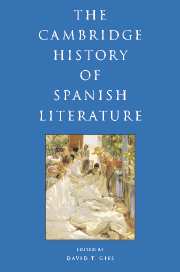Book contents
- Frontmatter
- I INTRODUCTION
- II HISTORY AND CANONICITY
- III THE MEDIEVAL PERIOD
- IV EARLY MODERN SPAIN: RENAISSANCE AND BAROQUE
- V THE ENLIGHTENMENT AND NEOCLASSICISM
- VI THE FORGING OF A NATION: THE NINETEENTH CENTURY
- VII THE MODERN, MODERNISMO, AND THE TURN OF THE CENTURY
- 32 Nineteenth-century women writers
- 33 The Catalan Renaixença
- 34 Great masters of Spanish Modernism
- 35 The poetry of Modernismo in Spain
- 36 Modernism in Catalonia
- 37 Modernist narrative in the 1920s
- 38 Noucentisme
- 39 Ideas, aesthetics, historical studies
- 40 The Catalan Avant-Garde
- VIII TWENTIETH-CENTURY SPAIN AND THE CIVIL WAR
- IX IN AND OUT OF FRANCO SPAIN
- X POST-FRANCO SPANISH LITERATURE AND FILM
- Bibliography
- Index
37 - Modernist narrative in the 1920s
from VII - THE MODERN, MODERNISMO, AND THE TURN OF THE CENTURY
Published online by Cambridge University Press: 28 March 2008
- Frontmatter
- I INTRODUCTION
- II HISTORY AND CANONICITY
- III THE MEDIEVAL PERIOD
- IV EARLY MODERN SPAIN: RENAISSANCE AND BAROQUE
- V THE ENLIGHTENMENT AND NEOCLASSICISM
- VI THE FORGING OF A NATION: THE NINETEENTH CENTURY
- VII THE MODERN, MODERNISMO, AND THE TURN OF THE CENTURY
- 32 Nineteenth-century women writers
- 33 The Catalan Renaixença
- 34 Great masters of Spanish Modernism
- 35 The poetry of Modernismo in Spain
- 36 Modernism in Catalonia
- 37 Modernist narrative in the 1920s
- 38 Noucentisme
- 39 Ideas, aesthetics, historical studies
- 40 The Catalan Avant-Garde
- VIII TWENTIETH-CENTURY SPAIN AND THE CIVIL WAR
- IX IN AND OUT OF FRANCO SPAIN
- X POST-FRANCO SPANISH LITERATURE AND FILM
- Bibliography
- Index
Summary
In Spain as elsewhere the 1920s saw a wave of experimentalism in fictional narrative. Modernist narrative, however, cannot be circumscribed to the historical Avant-Garde of the 1920s. Clear precedents can be traced back to the 1890s. The Pío Cid novels (1897–1898) of Ángel Ganivet, as well as some of Galdós’ later work, already evince some of the characteristics that will become the hallmarks of Modernist fiction. The well-known 1902 novels of Unamuno, Baroja, Azorín, and Valle-Inclán confirm an emerging trend, but it is the appearance of Unamuno’s Niebla (“Mist”) in 1914 that sets the seal. Here are visibly present many of the central preoccupations of Modernist narrative. Such concerns as the self-conscious text, the nature of artistic autonomy, the role of language, the identity of the self, and authenticity of the image are all given prominence in this work. Baroja was at his most innovative in his early work but, despite a strong defense of Modernism in 1903, never developed into a leading-edge experimental novelist, preferring in his later years to return to a highly personal brand of documentary Realism. Azorín on the other hand moved from an amorphous Bildungsroman-type novel in the first decade of the century to a more radical exploration of Modernist themes such as time, writing, and creative doubt in Doña Inés (1925), El caballero inactual (‘The Unmodern Gentleman,” 1928), and El libro de Levante (“The Book from the Levant,” 1929), each more rarified than the preceding one and demonstrating only too well the danger of artistic introversion.
- Type
- Chapter
- Information
- The Cambridge History of Spanish Literature , pp. 520 - 531Publisher: Cambridge University PressPrint publication year: 2005

